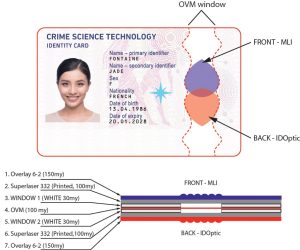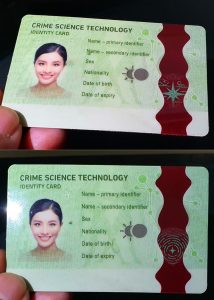Robust Optical Features for Cards Simply Applied by Lamination Plates
By Dr. Yit-shun LEUNG KI, Optical Features R&D, 4Plate GmbH/ProGravur AG
Counterfeiters are clever. Unconstrained by the imperatives of mass production, they dispose of both time and practically unlimited resources per card to produce high quality fakes. Furthermore, there is a growing supply of tampered-with “real” documents that are difficult to detect. Digital document verification can be circumvented by disabling the card or datapage chip (a few seconds in a microwave does the trick) and this will not necessarily raise flags at high throughput checkpoints such as busy airports, for even with a very high reliability, simple statistics mean that several perfectly legitimate documents with broken chips will turn up over any given shift. Absent the possibility of digital checking, verification of the document relies on the physical—mostly visual—security features on the card.
Opening a bank account, obtaining an official e-signature, age control, voting or renting a vehicle—in all of these cases as well, authentication of the ID document will often rest entirely on visual (level 1) and “assisted” visual (level 2) physical security features.
A new multi-level visual authentication feature
Developed during the pandemic, the Dual Optically Variable Image Device (or DOV-ID®) combines a reflective mode optically variable device (IDOptic® by 4Plate GmbH of Germany) applied on one surface of the card construction by a suitable lamination plate with an optically active layer placed in rough register somewhere in the middle of the card construction as shown in Figure 1.
 Figure 1
Figure 1
Here, the optically active layer is a fluorescent material (OVM® supplied by Crimesciencetechnology of France) occupying all or part of a clear window on the card. While OVM has many interesting characteristics, it is its fluorescent properties which are of interest to DOV-ID; namely that a first fluorescent color is displayed when the OVM-bearing window is placed against a dark background switching to a different complementary color when placed against a light background.
When viewed against a dark background, the reflective mode image formed by the IDOptic feature is in the fluorescent and complementary colors. As shown in Figure 2, the result is a very robust combined optical feature which is both simple to identify and easy to communicate. As with most optical features, the visibility of DOV-ID can be enhanced by illuminating the feature with a phone flashlight or any other handy unidirectional light source.
 Figure 2
Figure 2
How it works
In the configuration of Figure 1, the IDOptic feature is placed on the rear surface of the card with respect to incoming light. The light selectively reflected by the microrelief forming the surface feature image must transit through the OVM to reach the observer and is in effect equivalent to a light background. Thus, the foreground image information coming from the IDOptic feature is displayed in the complementary color while the background of the image and all other areas where there is no microrelief will appear in the fluorescent color. Ideally, the card design will have areas where there is no relief, useful for verifying the colors of the fluorescent material.
Where a card design does not include a clear window area, a similar result can be achieved by—for instance—substituting a color-shifting ink for the OVM and placing the IDOptic on the front side of the card construction with respect to the observer. Here, the combined feature will rely on the selective deviation of light emitted by the color-shifting ink when it passes through the IDOptic microrelief on its way to the eye of the observer, ideally rendering the image in the two colors of the color-shifting ink or more usually, depending on the viewing angle properties of the ink, in dark and light shades of one of the ink colors.
Robustness against counterfeiting
The above features are obtained by combining the light output from two different levels within the card construction. Tampering with the card to change the variable data will inevitably lead to the destruction of at least one of the optical components in the system, forcing the counterfeiter to produce a replacement. This is a much harder job than simply re-assembling the card after tampering. In addition, because one of the components is a surface feature, data modification by over-lamination becomes impossible as this would simply index out the image.
Robustness can be further enhanced by placing surface elements on the other side of the card denying access to the variable data layer from that angle as well.
A word on cost
Surface optical features are structurally low cost because they are replicated onto cards through the lamination process, using plates bearing the negative of the optical element. There are no external components such as holographic foil to be integrated and the solution is based entirely on consumables requiring no extra capex to be within the reach of any security-print certified integrator.
Conclusions
A new class of highly robust and cost-effective visual authentication features can be obtained by judiciously mixing the light output of elements at different levels of the card. The only limit is the creativity of the card manufacturer.
About the Author: Dr Yit-shun LEUNG KI of 4Plate likes to play with light and has been developing optical features since 2004.
